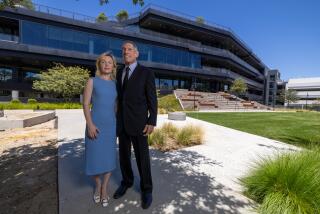UC Irvine Laser Institute Will Combine Research, Treatment
- Share via
The coil of clear fiber in Dr. Michael Berns’ hand suddenly turned vibrant red. He pointed the end of the fiber at the operating room wall, where the bright red light formed a sharp circle.
Against the pale aqua wall, the intense light beam of the laser was harmless enough. But Bern said that had the laser been directed at a tumor, the cancerous cells would have been burning off.
The surgical suite at the Beckman Laser Institute and Medical Clinic on the UC Irvine campus was packed Wednesday with members of the press interested only in a sneak preview of such technology. But starting Monday, the facility will be filling with patients, physicians and researchers looking for medical cures and discoveries through the aid of the bright light.
The laser institute, which hosted its opening ceremony Wednesday afternoon, is reported to be the first facility in the world where laser research and treatment will take place side by side. The $7-million building was specially designed around the lasers, which number more than 30, with a special laser distribution system, portable lasers and even special walls to diffuse an ill-directed light beam.
It also is the first UCI building financed entirely by the private sector--the Arnold and Mabel Beckman Foundation provided $3.5 million--and the first patient-treatment facility on the campus of the university’s College of Medicine.
Patients with cancer, vascular disease, eye problems, skin deformations and other ailments will be treated with lasers in six treatment rooms and the surgery suite on one side of the 25,000-square-foot building.
On the other side of the lobby, researchers will probe new ways to apply the laser, punching holes in cells with the light beam and injecting new genetic material, or slicing off chromosomes with the laser in genetic engineering studies. Down the hall, there is a suite where researchers will attempt to reattach nerves and fuse blood vessels with the light beam. In another room, veterinarians will be able to use the laser on ailing animals to treat their diseases and learn how the technique can be applied to humans.
The institute will be “looked at with envy by its distant cousins” at Harvard and other medical institutions, said Berns, the institute director and professor of surgery and cell biology. Work at the institute will “help unlock the mysteries of the cell” as well as lead to cures for blindness, cancer and other diseases, he told institute benefactors and other community members gathered for opening ceremonies.
The institute already has approval from the federal Food and Drug Administration for an experimental program to treat 40 patients with vascular blockages in their legs, and discoveries could lead to the use of lasers to unclog heart arteries, replacing bypass surgery, Berns told reporters.
Other potential patients for laser treatments at the clinic include children with “strawberry hemangiomas,” deforming, raised red birthmarks that often occur on the face and sometimes interfere with vision, officials said. Lasers will also be used for ophthalmic and gynecological ailments, plastic surgery to remove tattoos and “port wine” birthmarks, and urology disorders, Berns said.
Cancerous tumors can be reduced with lasers by injecting a dye that builds up in the tumor, said Dr. Alan Wile, a UCI surgical oncologist. The laser light reacts with the dye, destroying the cancerous cells, he explained. UCI, using laser facilities now located at the medical center in Orange, has used the treatments as a “last resort” on 206 patients under an experimental, FDA-approved program, and has had a success rate of 72%, Wile said, adding that the program holds promise especially for bladder, head, neck, esophagus and other surface tumors.
The Beckman clinic has two recovery rooms but is limited to outpatient treatment. While officials foresee most patients walking in and leaving after half a day, hospitalized patients can be transported to and from the building by ambulance, Berns said.
One distinctive design of the institute is a “fiber-optic distribution system” that allows a stationary $100,000 laser, located in its own room off the surgical suite, to be used anywhere in the building. Designed by Newport Research Corp., the system feeds the light beam from the laser machine into fibers that lead into outlets in all treatment rooms. By plugging another fiber into the appropriate outlet, the physician can tap into the laser, Berns explained.
In addition to spearheading the institute’s construction, biomedical industrialist Arnold Beckman also has established an endowment for the institute’s expenses and will match others’ contributions dollar for dollar. Beckman, a photochemist by training, said he became “intrigued” by the future for lasers after a presentation Berns made to him about five years ago. He was especially impressed, he remembered, by the capacity of the laser to slice off a cell’s chromosomes and by the light beam’s “kill ratio” in destroying cancerous cells and leaving healthy cells undamaged.
He also was impressed by Berns, Beckman said, adding, “He’s the No. 1 person in this country in the clinical application of lasers.”
Beckman officially opened the institute bearing his name Wednesday afternoon by slicing through the ceremonial ribbon with a hand-held laser. The same technique was used 19 months ago at the institute’s ground-breaking ceremony, and Berns was later warned by the FDA that he should have received authorization beforehand for the “laser light show.”
This time, Berns said, he obtained the appropriate approvals after reminding the federal agency that he wrote their safety regulations for laser use. Besides, he told the crowd, “we have a lot more lasers than they do.”






